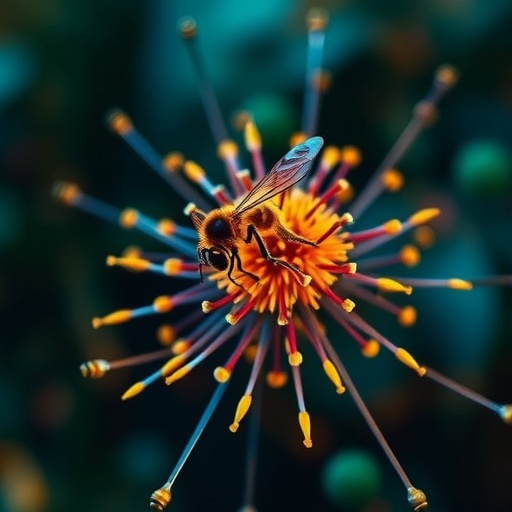Recent advancements in artificial intelligence are taking significant inspiration from nature’s own methods of collaboration and coordination. Scientists have investigated the behavior of social animals, such as birds, fish, and bees, which demonstrate the remarkable ability to operate cohesively without a central command. This study explores how these natural phenomena can be replicated and harnessed through robotic systems that embody what is known as “artificial swarm intelligence.”
The complex dynamics of flocking and swarming have long captivated researchers, who have seen potential applications in various fields, such as search-and-rescue missions, environmental monitoring, and agricultural efficiency. This latest research, documented in the esteemed Proceedings of the National Academy of Sciences, illuminates a framework applied to robotics that could refine swarm intelligence, enabling drones and other robotic systems to replicate the finesse found in their biological equivalents.
Central to this research is the challenge of decentralized control—a feature inherent to natural swarms. Unlike human-designed robots that often rely on a single point of command, natural systems thrive under decentralized principles. Animals such as fish, for instance, utilize intricate social networks to facilitate movement and decision-making processes. Matan Yah Ben Zion, an assistant professor at Radboud University and a co-author of the study, elaborates on this by noting that natural swarms exhibit structural magnificence without centralized leadership, contrasting with current limitations in synthetic swarming technologies.
To tackle the complexities related to the control of robotic swarms, the international team of researchers, including scientists from New York University, developed a set of geometric design rules to govern the formation of self-propelled particles. Their approach utilizes natural computation, analogous to the forces that determine the interactions between protons and electrons—a foundational concept in physics and chemistry. This mathematical underpinning allows synthetic swarms to operate with enhanced efficiency and dexterity.
Key to the framework the researchers proposed is a property referred to as “curvity.” This intrinsic characteristic enables active robotic particles, when influenced by external forces, to curve their paths. The manipulation of curvity allows for the orchestration of collective behaviors within the swarm, granting the potential to dictate whether the robotic formations will flock together, flow in a designated pattern, or cluster in specific areas. Achieving this level of control opens new avenues for application, presenting solutions to challenges faced in autonomous robotics.
In a series of experimental validations, the research team provided evidence for the efficacy of their curvature-based criterion, successfully demonstrating its ability to guide interactions among robotic pairs. This mechanism was observed to scale efficiently to thousands of robots, presenting a transformational concept in swarm robotics. The robots were engineered to possess curvity as a charge-like attribute, facilitating mutual interactions in a manner paralleling electromagnetic physics.
The studies underline the profound implications of adopting curvity in robotic design, allowing these machines to mimic natural swarming behavior closely. Ben Zion articulated that detaching from conventional design paradigms opens up possibilities for vast applications ranging from large-scale industrial robots to microscopic entities capable of medical tasks, such as targeted drug delivery, signifying a leap toward practical uses of engineered swarm intelligence.
Examining the robust nature of these geometric design principles brings a new perspective to the field of material science as well. This research assists in transcending issues associated with controlling swarms, converting this challenge into an opportunity for material innovation. Such advancements bear the potential to influence swarm engineering paradigms, making the implementation of these design rules straightforward in future robotics projects.
Among the notable advantages of the proposed framework is its foundation in basic mechanics, which facilitates the transition from theoretical modeling to practical applications. This leap from concept to realization is crucial for the advancement of swarm robotics, as researchers can leverage established mechanical principles to create more sophisticated and controllable robotic systems.
For robotics scholars and industry professionals, the research provides invaluable insights into the mechanisms that govern swarm intelligence. It highlights not only the inherent efficiency of decentralized systems but also the applications that could benefit from enhanced control mechanisms over robot swarms. The prospects of implementing this technology extend into various sectors, including disaster response, environmental conservation, and agricultural management, showcasing the utility of mimicking biological systems in artificial constructs.
Overall, the research signals a pivotal shift in the understanding and application of swarm intelligence in robotics. By taking cues from nature and implementing geometric design rules, the scientists have laid the groundwork for next-generation robotic systems capable of mimicking the fluid, coordinated movements observed in nature. Such advancements could herald a new era in robotics, where machines learn not just to work alongside humans but to operate cohesively in their own natural-like systems.
As we venture into an era marked by increasing reliance on AI and robotics, the integration of these principles into engineering will likely yield innovative solutions that are more adaptive and responsive to real-world challenges. The convergence of swarm intelligence with emergent technologies may inspire breakthroughs that enhance productivity, safety, and efficiency across multiple domains, inviting both excitement and anticipation for future developments in this dynamic field.
By marrying concepts from nature with advanced design principles, researchers are not just revolutionizing the technology sector but potentially changing the future trajectory of interaction between humans and machines, where collaborative and coordinated efforts foster a new standard of operational excellence in robotics.
Subject of Research: Artificial Swarm Intelligence in Robotics
Article Title: A geometric condition for robot-swarm cohesion and cluster–flock transition
News Publication Date: 8-Sep-2025
Web References: DOI Link
References: Proceedings of the National Academy of Sciences
Image Credits: Image courtesy of the Department of Artificial Intelligence, the Donders Center for Cognition, Radboud University. Photo Credit: Luco Buise.
Keywords
Artificial Intelligence, Swarm Intelligence, Robotics, Decentralized Control, Curvity, Natural Computation, Self-propelled Particles.
Tags: advancements in AI researchagricultural robotic efficiencyapplications of swarm behaviorbio-inspired algorithms in technologycollaborative robotic systemsdecentralized control systemsenvironmental monitoring technologiesnature-inspired artificial intelligenceProceedings of the National Academy of Sciences researchsearch and rescue roboticssocial behavior of animalsswarm intelligence in robotics





